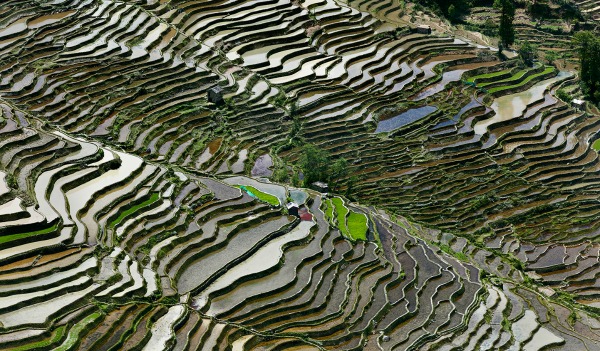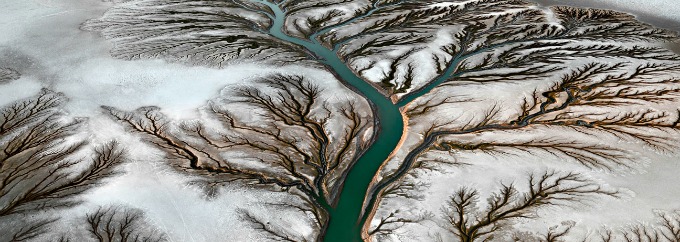A feast. An overjoyed eruption of pixels, of an almost pornographic proportion. This fetish of the photographic is a documentary at its most elemental and Vertovian. It’s visuals deserve the big screen. It can stun – although, after a while, one may feel that it is also repetitive.
WATERMARK is a collaborative work from filmmakers Jennifer Baichwal and Nick Pencier, and photographer Edward Burtynsky. As in their previous film, MANUFACTURED LANDSCAPES, which portrays the industrialised world, WATERMARK explores the connection of human and landscape. It is a large scale portrait-in-motion of the relationship human-kind have with water, depicted in various contexts, ranging from the agricultural, to the religious, to the decorative. For the film, water is something to be subsumed, subjugated, enslaved, feared, cajoled and played with.
The film employs similar approaches to KOYAANISQATSI, a landmark documentary on landscapes. The preoccupation with scale and patterns, the techniques of slow motions, time-lapses, and the juxtaposition of images and sound combine to overwhelm the senses – so much so that the absence of a conventional narrative itself is a problem. Indeed, some of the cameraworks and editing resemble those performed in LEVIATHAN, the fishing industry documentary, foregoing a traditional storyline or commentary, focusing instead on the sensory experience.
At its best, WATERMARK can be both visceral and meditative. The surfaces of Earth and the movement of water presented on screen can look intimidating and otherworldly, generating a feeling of awe. These series of scenes, however, taken from various geographical locales can lead to the gradual diminishment of this sense of wonder. Over the course of the film, one may even become desensitised towards the stunning images. One eventually yearns for the film to zoom further in from such a height and magnify the people it shows, and further highlight their struggle with and in water. Some scenes do this, showing people on ground level whose faces, bodies and activities mirror the contours of the landscape they exist in, in turn reflecting the way water moves there. Their snippets of stories indicate intimate relationships with water, across the emotional spectrum. This promises the intensity akin to those conveyed in WORKINGMAN’S DEATH, a work of the recently departed Michael Glawogger, following humans in labours on and within the landscapes. Or indeed the poetic obsession in Herzog’s ENCOUNTERS AT THE END OF THE WORLD, which shows humans in thrall to the landscape. However, in WATERMARK, the people at times feel more like the accessories to the landscape. The film would rather soar and examine from afar.
…foregoing a traditional storyline or commentary, focusing instead on the sensory experience…
This strategy is a valid one, especially given the technology at its disposal, the expertise of the filmmakers and, perhaps, the global predisposition of the film. However, the shifting focus and the relative lack of insight into the human conditions contribute to a sense of detachment. The rhythm of the film itself feels to be somehow interrupted by the periodical appearances of the photographer, Edward Burtynsky, at work on the subject.
The film is still very much worth watching. It reveals the hidden power and complexities of an ubiquitous subject, often taken for granted. It invites the audience to contemplate their own relations with water, an increasingly precious item becoming more expensive to deliver to the human population. On big screens, however, these may disappear, the films simply transport the audience away.
httpvh://youtu.be/5Yvu7-iP7gY


